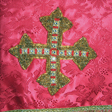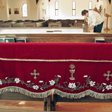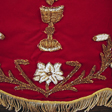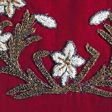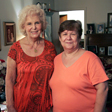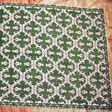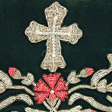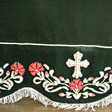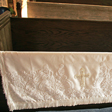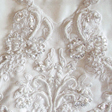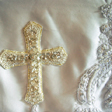Other Shreveport Articles
Cultural Preservation: Keeping the Flame Burning for Future Generations
Seasons and Cycles — Festivals and Rituals Mark Life's Rhythms
Of Hand and Heart: Handwork Connects Family and Community

Shreveport's Greek Community: Cultural Treasure Spanning Generations and an Ocean
Threads of Continuity Through Lives of Change: The Handwork of Dena Kosmitis and Magda Panos
More recently, congregants Magda Panos and Dena Kosmitis have made altar cloth sets for St. George. Dena and Magda are both active members of St. George Greek Orthodox Church. Their immigration stories are quite different. Dena was born and raised in Nestane, a small village built into the side of a mountain in southern Greece. She remembers good, cold water and a grape arbor growing alongside her childhood home. Dena's family grew their own wheat and corn, made their own wine, raised chickens, and kept a goat and a pig. A nearby Orthodox monastery was the site of many celebrations, including August 15, when people commemorate the Dormition of Mary, or when Mary goes to sleep (dies). People came from all over to attend this celebration, one of the most important in the Greek Orthodox calendar.
Dena's father was a blacksmith. He made tools like ploughs and scythes, and repaired farming equipment. Dena remembers helping her father, working the bellows to keep a fire going while he heated and shaped metal into tools. Idyllic as this setting sounds, Dena grew up during a difficult chapter in Greek history. Born in 1935, she experienced an economic depression, World War II, and the Greek Civil War. During the depression in 1941, people were starving. Dena remembers there being no oil, no salt, and no lemons. The scarcity of matches compelled neighbors to go from house to house in order to light a fire. Dena's family did comparatively well, as her father exchanged blacksmithing for eggs, milk, flour, and other staples. He was the only blacksmith for three or four towns, so people came from all over to seek his services.
After World War II, the Greek Civil War further ravaged the country from 1946 to 1949. Dena remembers it as a time of destruction, looting, and killing, when brothers fought against brothers. At this time, her father immigrated to the U.S., settling in Gary, Indiana where he worked in the steel mills. He sent for his oldest daughter and in 1951, when she was 16, Dena and a cousin sailed to New York and then took the train to Chicago.
For several years after her arrival in the States, Dena remained in Chicago, where she lived with family, worked, and attended school to learn English. A few years later, she married her husband and moved to join his family in Louisiana, outside of Shreveport. There she found an established Greek community, the first generation to settle in the area.
Dena and Magda Panos met in 1976, when Magda arrived in Shreveport as a new bride. Her husband, Chris Panos, had immigrated to Shreveport in 1951. In the midst of hardships in post-war Greece, Chris Panos and his brothers followed family who had earlier immigrated to Shreveport. The Panos brothers established several restaurants. Today, Chris and Magda Panos still operate Panos Diner on Milam Street in downtown Shreveport. The business has been in the family for 37 years. The couple met when Chris Panos was visiting family in Magda's home town, Ioanna, a big city in northern Greece, near the Albanian border.
Magda Panos was born in 1949, squarely missing the wars that devastated her country. She speaks with pride about her hometown, Ioanna, a city that encompasses a lake with an island in the middle and is well known for its silversmithing tradition. She got her first taste of America going to the movies with her family. Gone with the Wind, Oklahoma!, and John Wayne pictures are among the films she remembers. Magda was 27 years old when she married and left Greece to be with her husband. She could just as easily have stayed in her home country, where she had a happy family life, a vibrant hometown she loved, and a tailoring business through which she earned her own money. Unlike Dena, who of necessity left Greece for a better life, Magda moved to the United States for love.
Magda and Dena made the altar cloth sets using techniques they learned when they were growing up in Greece. Although they were raised in different times and regions, both women come from families in which handwork was a valued skill. During Magda's youth girls stayed home all the time, cooking and cleaning and doing handwork, making things to beautify the home. When she was little, Magda began learning to sew, crochet, and embroider from her mother and her grandmother, who were both accomplished at handwork.
Dena and Magda remember their mothers weaving in their childhood homes. Dena recalls her mother weaving on a huge floor loom in their home, making blankets and fabric for clothing from locally grown sheep's wool and cotton. Magda's mother also wove cloth, but on a different loom that was designed for making thinner cloth. Before World War II, Magda's mother worked in a factory making light material. Magda's father had his own shop, where he made and sold headscarves. He printed the scarves by hand, using blocks he'd carved from wood, and natural and commercial dyes for colors. At the time, it was traditional for women from the villages to cover their heads. The scarves' designs reflected the regions where they were made. Magda's father's scarves were recognizable as coming from northwest Greece. He was also a talented silversmith who made items for their home.
Dena's favorite handwork medium is sewing. She learned to sew in high school, where she was taught to make smaller items. At home, she used her mother's sewing machine to make clothing. Another popular art form at that time was cross-stitch embroidery. Dena had an aunt who put her to work doing cross-stitch, but would inevitably get mad when Dena unintentionally pulled threads while she worked. Years later, after she married, Dena's sister-in-law showed her how to use a cross stitch pattern and she learned little by little, "hit or miss!" as Dena describes it.
During her youth, Magda spent summers with her mother's cousin, who was a seamstress. Although she loves to sew, she does not remember her apprenticeship fondly, as she was not allowed to go out and play. Ultimately, however, this training served her well, as Magda developed her own dressmaking business. She designed and made clothing from scratch, using her own patterns. Sometimes she worked in her own home, or she would spend the day in her customers' homes, cutting fabric and making clothes. At night, when she wasn't working, she did cross-stitch. Magda's cross-stitch embroidery is quite detailed, especially considering that there are no patterns drawn on the cloth. She simply counts the threads in the fabric to achieve her design. Dena observes that this work requires a lot of patience!
Magda and Dena both remember the Greek custom of assembling a prika or trousseau. In anticipation of her wedding day, a girl would make things for her new home, mostly at night when she had nothing to do, especially in cool weather. Dena and Magda point out that there was no television during their childhoods. Two days before a girl's wedding, she puts out all of her handwork for friends and family to see. In Dena's village, women got together in the evenings to do handwork. She remembers her mother, grandmother, and cousins gathering, as each woman worked on her own project. Neighbors would also come together for these sessions. Dena recalls this as an inspiring time. People would look at each other's work and see who was making what, and come away with new ideas. Because she was away at school for much of her youth and then immigrated to the U.S. as a teenager, Dena did not get to participate in the prika custom.
When it was time for St. George Greek Orthodox Church to have some new altar cloth sets, Dena and Magda put their traditional handwork skills to use. At Father Brendan's request, they made four sets, each in a different color corresponding with particular times in the Orthodox calendar. For set used from November 16th through the Christmas season, Father Brendan requested a green velvet background and a pattern that incorporated carnations—a flower that is often used at St. George. While she was designing this set, Magda looked for inspiration at books with photos of older pieces. Drawing from multiple patterns, she put together elements from diverse sources to come up with a design she liked. Using a technique she learned in Greece, she embroidered red carnations with silver trim in beads on a piece of fabric. She then cut around the crosses, flowers, and leaves and sewed the motifs onto a deep green velvet background. Over six months, Magda worked on this set at night. The results are nothing short of magnificent.
The technique of embroidering designs first on one cloth and then cutting it out and sewing it onto another extends the life of the intricate embroidery. Among the historic altar cloth sets in St. George's collection is one stitched in a lily pattern with white and gold beads on red velvet by the late Mrs. Stamatia Stravolemos. The date it was made is unknown, but it is among the church's older altar cloth sets. In the late 1960s or early 1970s, Dena and another woman from the church removed the embroidery from the original background cloth, which had worn out, and sewed the beaded motifs on a new red velvet backing. Dena and Magda remember with reverence the earlier women of the church who were their predecessors and mentors. "These women were great," Dena recalls. Speaking of their embroidery and sewing, she says, "They did great, great work."
For a white-on-white altar cloth set that is used at Easter time, Magda and Dena worked together. Dena's daughter donated all of the materials, which include a white satin background, with pearly white beads, sequins, braiding, and several other layers of fabric. Dena and Magda designed the set together. Each woman embroidered the crosses and the floral motifs, which they cut out and sewed onto the white satin. Magda worked on the outside motifs, while Dena made the inside ones. The final product is exquisite, glimmering with the talent of these two women and their devotion to their church. Each set contains eleven pieces, including an altar cloth, a cloth that covers the communion bread and one for the wine chalice, a cloth for the Bible, and several others.
Magda and Dena both participate in St. George's women's auxiliary organizations, the Philoptochos Society and the Daughters of Penelope. The St. George chapter of the Philoptochos Society grew out of an earlier women's organization formed to raise money for the church. Eventually, the group went under the regional diocese and became part of the national Philoptochos network. The Philoptochos Society is the first Christian women's auxiliary women's organization in the United States. Philoptochos translates as "friend of the poor." The organization does philanthropic work, while also supporting the church. Philoptochos has district, national, and international chapters. In diaspora, the society is a natural extension of the tradition in Greece, where all churches have a Philoptochos Society.
In contrast, the Daughters of Penelope originated in the U.S. The Daughters of Penelope, which recently celebrated its 90th anniversary, was founded by a group of women in San Francisco as a women's auxiliary to the men's organization, the American Hellenic Education Progressive Association (AHEPA). Dena explains that Greek immigrants organized AHEPA and Daughters to promote Greek language and heritage in their new home. She says, "It was more so they'd be known, the Greeks, to [allow others to] see what we stand for. To educate the people in the United States." Today, the Daughters of Penelope is an international organization, with chapters in Greece, Cyprus, Canada, and Australia.


